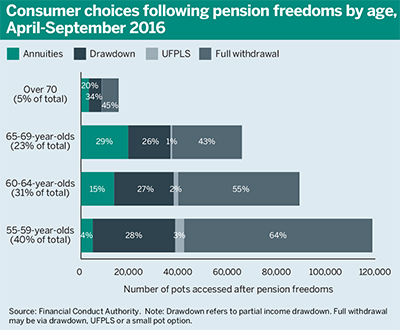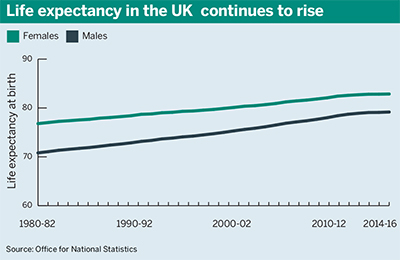Five defined contribution experts talk about deferred annuity products, retirement expectations, and how the industry is adapting to people's changing work patterns.

How will the retirement income market need to change to adapt to evolving working habits, such as working part-time later in life?
Laura Myers: Improved online servicing is a likely step-change. I think members will want their pension providers to offer the functionality that they have grown used to from savings accounts and other online services. Members will want to easily and instantly be able to see the total pot value, the monthly standing order, be able to change the regular amount they are drawing down or just instantly withdraw a one-off payment. But this level of independence needs to be supported by sufficient education – members will need their providers to invest in modelling tools and guidance or advice to ensure the flexibilities are used successfully and appropriately.
Another area that will be key to helping members make decisions about their retirement is the ability to quickly and easily amalgamate pots. On average, members accumulate 11 pension pots in their lifetime. Making decisions of this magnitude when your assets are divided piecemeal over several schemes can be very hard.
The pensions dashboard would be key to solving this issue, by helping summarise members’ accounts so they make the best decisions about their own retirement. Therefore, I think we need the dashboard to be compulsory for all schemes to help future members take control of their finances and make key retirement decisions about what they can afford and how long they need to work.
Dianne Day: The ‘U-curve’ of retirement expenditure is pretty well understood. This often involves high income requirements while retirees are active, followed by low income requirements as they become more sedentary. Income requirements then increase again when the retiree is in a care home, for example. However, there are no products designed to match this anticipated spending pattern, partly because it is extremely individual and unpredictable.
With extended longevity, it is likely that many people will work longer relative to previous generations – either through choice or necessity. This can be driven by both financial and social considerations; feeling connected and valued through work is important for many people. Our working patterns in retirement – whether part-time, full-time or self-employed – can be less predictable and retirees will need flexible income sources.
Maria Nazarova-Doyle: The days of having a cliff edge retirement are over, there is no doubt about it. Instead of an abrupt lifestyle change, retirement is now a much longer process spanning years, and potentially decades, particularly if age 55 is the starting point.
The investment strategies that are being used need to adapt to this paradigm shift. To begin with, accumulation defaults should take this into account, and not target a specific outcome at a specific point in time – as this approach is likely to not benefit anyone.
Sixty-seven per cent of DC savers access their benefits early, while a fifth of members do so late, according to JLT research. Only 14 per cent are doing it at their scheme retirement age. What this shows is that we really have no idea when a particular person will want to have some or all of their cash, and default construction should be designed with this issue in mind. The same requirement would then apply to post-retirement strategies. We live our lives in a completely different way to previous generations, and investment products should evolve in line with our changing needs.
Alistair Byrne: Firstly, default investment strategies used in the accumulation phase need to be structured to allow members to keep their options open in relation to retirement. The target date glidepath should not assume a precise and fixed retirement date or particular means of accessing the member’s savings, but rather provide flexibility as to when and how.
Most target date funds focus on a window of retirement dates – 3 or 5 years – rather than a precise date. We know members’ plans change in the face of the uncertainty of life. The pension freedoms provide valuable flexibility to allow members to adopt different working patterns, for example gradual use of DC savings to supplement reduced income when working part-time as part of a phased retirement.
We also think state pension systems need to be more flexible, with greater choice of when to claim, and the option for partial deferral. This can help support people who want to work part-time in the early years of retirement and benefit from a higher level of state pension in their later years from the deferred portion.
Naomi L’Estrange: In the current system, there is too much focus on a single retirement date and age, with most individuals having no understanding of the importance of their choice of retirement age, or even what that date is. Here the answer is a simple low-cost default pathway assuming a gradual switch into drawdown over a period of time rather than a single date.
Do the high costs of deferred annuity products represent a problem for default retirement solutions, and how could these be avoided?
Byrne: Cost has to be viewed in the context of the overall retirement income solution. In the US, we are working on a product that combines flexible drawdown with a deferred annuity. The income levels through both phases are attractive relative to the amounts that could be taken via drawdown without risking a high probability of running out of money.
Roughly 25 per cent of the pension pot at retirement goes to the deferred annuity. We expect annuity pricing to become more competitive as the market develops with more providers, including the availability of reinsurance. We also see scope for non-annuity based solutions, that provide some but not all of the benefits of an insurance-based secure income.

L’Estrange: The cost of deferred annuities largely reflects the genuine cost of holding sufficient capital to guarantee the cashflows for life, especially in a low-yield environment. However, insurers are also guilty of offering uncompetitive pricing to those who do not shop around.
The trustee and independent governance committee community should work together with regulators to ensure that pricing is fair, that the benefits of new asset classes offering a margin over gilts are passed on to individuals, and to test overall profit margins. But perhaps more significant is the ‘bad name’ annuities have. When asked what they want, most individuals say they are looking for a guaranteed income in retirement, but are adamant that they do not want an annuity. Constant reference to how expensive they are is arguably feeding into a general misunderstanding on the part of consumers of how long they are actually likely to live, and how much money they will need to support that.
Given that the main benefit of an annuity is to cover the tail risk of living longer than expected, and that annuities get cheaper as members get older, one possible answer is for a default to include an annuity of all or part of the fund at age 75.
However, it should be remembered that for the generation retiring over the next 20 years, a significant proportion will have some, albeit probably not enough, defined benefit pension that might cover that tail risk and make cash, drawdown or ‘lumpy’ drawdown more suitable.
Nazarova-Doyle: In theory, deferred annuities should be a relatively cheap way to insure against longevity risk. In practice, EU regulations around capital requirements for insurers cause them to be extremely cautious in their investment strategies and pricing, leading to a practically unaffordable position for those individuals looking to access these instruments. Unless this approach changes, we will not see the prices substantially reduced, meaning that the use of these instruments in retirement planning will be extremely limited.
Day: The reasons why annuities are less popular these days also apply to deferred annuities – buying a deferred, long-term income stream with a longevity hedge is expensive. It is difficult to factor these into default retirement options and individuals are put off by the risks of dying early and upfront cost.
Alternative investments that give individual retirees more flexibility may be better suited, such as direct fixed-rate securities held to maturity. Perhaps as the DC retiree market expands, providers will see higher demand, and one would expect price to come down if demand goes up.
Myers: Deferred annuities are expensive, and only a limited number of insurers offer them, which does not help with the pricing.
Instead of purchasing deferred annuities, providers could create solutions that start in drawdown until a member is, say, 70 to 80 years old and then use the remaining assets to purchase an annuity. Deferring annuity purchase is often more cost effective, typically giving members an extra £1,500 a year income per £100,000 when purchasing at 75 rather than 65. Using this strategy with an income-producing drawdown strategy for ages 65 to 75 could give a better overall outcome for members.
Is there a need to change assumptions of a recreational retirement?
Nazarova-Doyle: Recreational retirement? What is this? I think this was something I heard stories about when I was growing up. Working in the pensions industry, we, the DC generation, are only too aware of the bleak prospects and later life struggles that insufficient saving and bad quality investment strategies could bring upon us.
However, we still need to work on the general public’s perception of how pensions work. Too many people still think that they are guaranteed or promised something by way of a pension when they stop working.
Unfortunately, a scenario whereby things get worse before they get better is almost inevitable. People need a wake-up call to engage with their pensions saving and future financial planning in a meaningful way.
We will probably need to see one generation struggle for the next one to learn from their predecessors’ mistakes. Hopefully, all the educational efforts of scheme trustees, employers, the consulting industry and the government will bear fruit and do enough good to prevent a retirement income disaster in the UK.
Byrne: Retirement will increasingly be made up of a number of phases. The initial early phase will typically be active, with increased leisure and recreation alongside some ongoing element of part-time work. That work may be in the individual’s existing role or occupation, in a new role more suited to retirement, or quite simply something they have always wanted to do.
At some point, the active phase gives way to a period of more traditional retirement, where work has stopped and there is a focus on leisure. At this stage a secure regular income becomes more important. The length and timing of the stages will vary by individual, but for most the fully retired stage will be later in life than has been the case traditionally.

Myers: Crucially, people will have to change their mindset around retirement. The current retirement view really comes from the significant improvements in life expectancy we have seen over the last century and the comfortable DB pensions that many of today’s retirees have.
While I do think that having an expectation of funding a healthy and long retirement is a good thing, if we are to maintain these expectations something has to give – members have to save more, work longer or work differently.
But can we get people to save more? I think that is a serious challenge. Intergenerational differences in wealth have rarely been so pronounced – with many current retirees enjoying the benefits of their DB pension and booming property values. My concern is for our current generation of DC-only savers – often struggling with debt from education, in a spiral of renting and faced with a DC pension they have been auto-enrolled into.
We therefore need to educate employees to understand the significant benefits of employer contributions, tax savings, and compound returns before we lose them from pension saving completely – something I think is a real risk over the next few years as the cost of increased auto-enrolment contributions will be weighed against the cost of immediate survival pressures.
If saving more is hard, this means we need to work longer, both before retirement and then into retirement to supplement our pensions, rather than retiring completely.
Day: Does a widespread assumption of a recreational retirement still exist? For all but the very well funded retiree, this presumes continued health and access to a range of state benefits that may no longer be realistic.
Perhaps the development of the online world and social media will change how that recreation takes place. I have read about golf courses, for example, closing due to lack of members with the time to play 18 holes – but will we exchange that for satellite TV golf, virtual reality or online dating? I think the combination of longevity and decreased job security has changed many peoples’ expectations of how they will spend their time in retirement.
L’Estrange: I think this question is getting at the fact that all future generations simply will not have enough pensions to retire completely. While this is true, and a potential disaster, there are also silver linings here. We now all live longer, and healthier for longer, lives. It simply does not add up for everyone to down tools at 55 and live for longer in retirement than they spent in work.
Not only are pensions insufficient, but we also need tax revenue for longer to meet the increased health and social care costs of an ageing population. Keeping mentally and physically active also makes for a happier and healthier old age, and this is arguably even better met by work than by golf.
This is a very big question where the answers might include more gradual phased retirement, as well as government policies and metrics that properly measure, value and financially support the huge contribution older people make to the economy via their care of each other and their grandchildren, and enable productive use of their time and wisdom by the wider community. Structuring pension products that work in this context is easy in comparison.
Click here to read part one on default retirement pathways, flexibility and guidance














